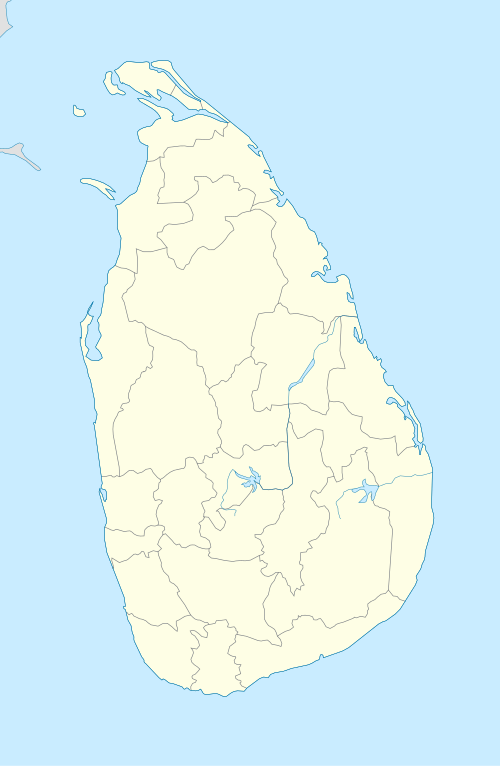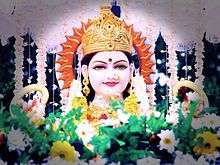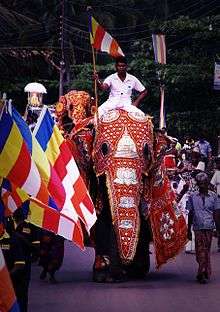Nawagamuwa Pattini Devalaya
| Nawagamuwa Pattini Devalaya | |
|---|---|
 Location within Sri Lanka | |
| Geography | |
| Coordinates | 6°55′26.93″N 80°1′4.9″E / 6.9241472°N 80.018028°ECoordinates: 6°55′26.93″N 80°1′4.9″E / 6.9241472°N 80.018028°E |
| Country | Sri Lanka |
| District | Colombo |
| Locale | Navagamuva |
| Culture | |
| Sanctum | Goddess Pattini |
| Major festivals | Annual Perahera (August) |
| Architecture | |
| Architecture | 19th Century Architecture |
| Number of temples |
Maha Pattini Devalaya Dedimunda Devalaya Kataragama Devalaya Vishnu Devalaya |
| History | |
| Date established | A.D. 114 - 136 period |
| Creator | Gajabahu I of Anuradhapura |
| Website | http://www.nawagamuwadevalaya.org |
| Maha Pattini Devalaya | |
|---|---|
| Native name මහා පත්තිනි දේවාලය | |
| Type | Place of Worship |
| Location | Nawagamuwa |
| Founder | Gajabahu I (A.D. 114 - 136) |
| Built | Anuradhapura Period |
| Demolished | 14th century (1576) |
| Rebuilt | Late 14th century |
| Restored | 2016 |
| Type | National Historic Site of Sri Lanka |
| Part of | Sri Lankan Buddhist and Hindu Culture |
The Department of Archaeology (Sri Lanka), declared the Nawagamuwa Pattini Devalaya as an Archaeological Protected Monuments in Colombo District (22 November 2002) for its importance in historical, architectural and anthropological facets.[1] According to popular legends the early establishment of Devalaya goes back to 1st century AD.[2] Nawagamuwa also inherits archeological sites that dates back to BC period as per archaeological research conducted in the area.[2] The Devalaya is popular among the masses for its miracles and to receive the blessings of the goddess Pattini.[1]
Legends
The legend has it that Gajabahu I of Anuradhapura (A.D. 114 - 136) on his return from India victoriously with 12000 men as prisoners, also brought with him the Pattini anklet. The king built the Devalaya enshrining the Pattini anklet at a place where he stopped to rest on his return to Anuradapuara.[2][3] a different presentation of the legend says that the Goddess pattini came from India with 12000 devotees form 16 castes and settled in this area.[3]
History
Verifiable historical evidence about the Devalaya emerge during the Kotte period.[2][3] The area was then known as Hewagam Korale, according to Rajaveliya.[2] Excavations around the devale from time to time unearthed building materials, wells, Dutch coins and iron implements of the Middle Ages. North of the old devalaya at what was known as the old landing place, coins used during the Dutch period in Ceylon, 1554–1765, have been found.[2] Significant events took place during Kotte Period[2][3]
- Inauguration of Hewagam Korale by King Rajasinha I of Sitawaka as a gratitude to the soldiers of Hewagama who fought with him against the Portuguese in Battle of Mulleriyawa.
- Godagama Sannasa mentions about the gift of oil presented to Nawagamuwa Pattini Perahera by the King Buwanekabahu V (A.D. 1521–1580)
- King Mayadunne of Sitawaka (A.D. 1521 - 1580) had stopped at the Nawagamuwa Pattini Devale to make a vow before he went to war with the Portuguese in the Colombo Fort.
- Portuguese records reveals that, in 1550, the king of Portugal sent 600 troops to help Bhuvanaikabahu VII of Kotte. They clashed with King Mayadunne at Nawagamuwa.
- In 1576, the Portuguese records says that they made a military establishment on the place after destroying the Devalaya.
- King Mayadunne recaptured the lost land and rebuilt the Devalaya.
- The Captain of the Colombo Fort, again destroyed the Devalaya and leaving a pile of ruins
Festivals
The major festival of the Nawagamuwa Pattini devalaya is the ‘Gonpita Perahera’ held on the month of August very year. This traditional ceremony has been conducted for the past 1500 years in honour of Goddess Pattini, to invoke blessings on the village. The villages rear white bulls exclusively to take part in the annual perahera festival.[4]
Restorations
Archeological research has revieled that there are buildings in Nawagamuwa Devalaya premisers belongs to both Kotte Period and the 19th Century. The 19th Century restorations and buildings were done by Katuwawala Sri Sumanatissa Thero, the chief priest of the temple during A.D. 1813–1928.[2] After constructing the Galkanu devale, Sri Sumanatissa Himi constructed the monks abode or Sanghavasaya and the Vihare or Pilimage in 1894.[2]


After the restoration of the Devalaya in 1813 – 1928 period, the Devalaya haven’t had any restoration until the New Millennium.[5][5][6] In 2016, nearly hundred year later, the Devalaya went through a complete restoration, as per guidance of the Department of Archeology. The restoration includes, wood-work using exact type of Jak trees (that yielded honey- sweet fruits) used by original builders, in addition to cupper sheet roofing and granite flooring. The restoration cost 30 million rupees to complete. The project was funded by the Nandana Lokuwithana Foundation.[7] With the new renovation project, a life-size marble statue of Goddess Paththini was brought from India to Nawagamuwa.[5][5][6] It was unveiled to the public ceremonially on 19 August 2016.[5][5][6]
Conservation
The Department has declared eight archeologically important sites as protected monuments to be conserved[2][3]
- Shrine Room (Pilimage)
- The Monks’ Abode (Sanghavasaya)
- Stone Pillar (Galkanu) Devalaya
- Maha Pattini Devalaya
- Vishnu Devalaya
- Kataragama Devalaya
- Dedimunda Devalaya
- The grove of ancient Na trees (which is over 100 years old).
References
- 1 2 https://www.archaeology.lk/wp-content/uploads/2013/09/intenational_conference_on_asian_art_culture_and_heritage_colombo_sri_lanka_2013_august_final.pdf
- 1 2 3 4 5 6 7 8 9 10 http://www.angelfire.com/planet/heritagesl2/nawagamuwa/nawagamuwa.htm
- 1 2 3 4 5 http://www.sundayobserver.lk/2011/04/17/fea28.asp
- ↑ http://www.sundaytimes.lk/160911/funday-times/annual-gonpita-perahera-of-the-nawagamuwa-sath-pattini-devale-207967.html
- 1 2 3 4 5 6 http://www.news.lk/news/politics/item/14215-president-unveils-statue-of-goddess-paththini-at-nawagamuwa-devalaya
- 1 2 3 http://lankainformation.lk/news/latest-news/item/9880-president-unveils-statue-of-goddess-paththini
- ↑ http://srinews.lk/sinhala_news_page.php?id=63&type=Art